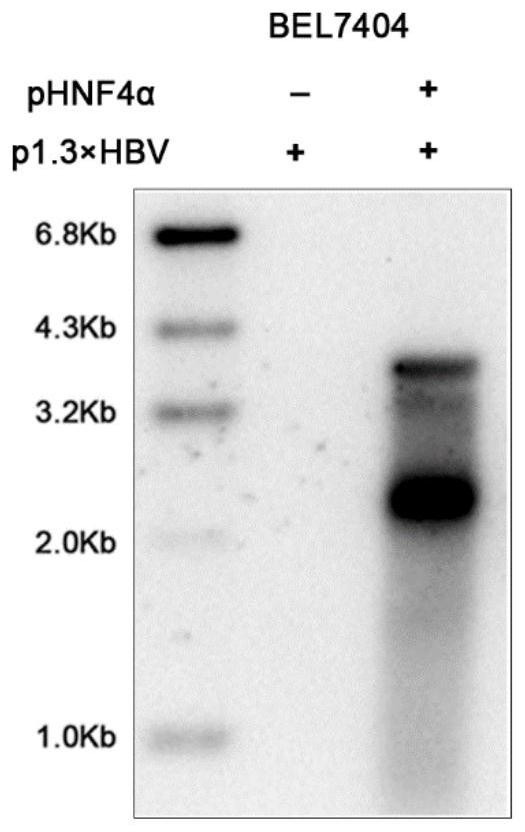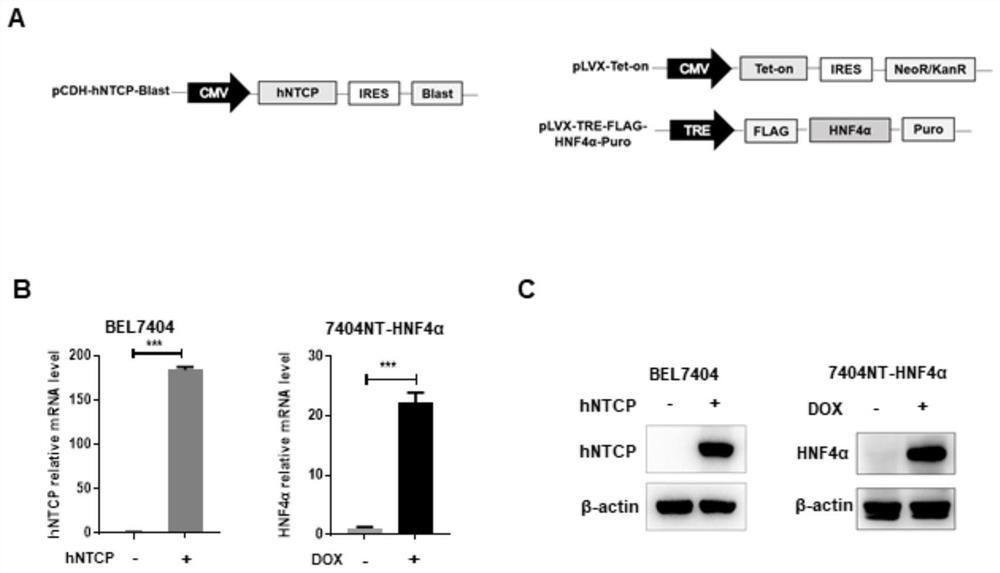Cell model capable of supporting hepatitis B virus replication and infection and establishment method
A cell model, hepatitis B virus technology, applied in genetically modified cells, chemical instruments and methods, botanical equipment and methods, etc., can solve problems that have not yet been applied, and achieve the effect of simple culture conditions
- Summary
- Abstract
- Description
- Claims
- Application Information
AI Technical Summary
Problems solved by technology
Method used
Image
Examples
Embodiment 1
[0063] Observe the transfection efficiency after BEL-7404 transfected pCMV-EGFP plasmid by fluorescence microscope and cell flow experiments:
[0064] 1. Inoculate BEL-7404 cells in a 6-well plate (the BEL-7404 cells are provided by the Chinese Academy of Sciences Cell Bank / Stem Cell Bank, catalog number is TCHu64) suspension (8 × 10 5 cells / well), the culture plate was pre-cultured in the incubator for 12 hours, and the cells adhered to the wall.
[0065] 2. Use 4 μl of Turbofect transfection reagent (Thermo Fisher Scientific, Waltham, USA) transfection reagent and 2 μg pCMV-EGFP plasmid in each well for transfection experiments, culture at 37°C for 48 hours, and observe the fluorescent expression effect under a fluorescent microscope. The experimental results are as follows: figure 1 As shown in A. The pCMV-EGFP plasmid in this step was constructed by the applicant himself, and the specific method was as follows: the EGFP cDNA sequence was cloned into the pCDN3.1 (V79520, I...
Embodiment 2
[0071] Southern blot experiments detected that overexpression of the HNF4α gene in BEL-7404 can support the replication of complete HBV. Specific experiments include:
[0072] 1. Inoculate BEL-7404 cell suspension (1×10 6 cells / dish), the culture dish was pre-cultured in the incubator for 12 hours, and the cells adhered to the wall.
[0073] 4 μg pHNF4α and 4 μg p1.3×HBV replicon plasmid were co-transfected into BEL-7404 cells using 16 μl Turbofect transfection reagent, and the control group was transfected with 4 μg empty plasmid and 4 μg p1.3×HBV replicon plasmid. After 96 hours, intracellular HBV DNA was extracted for Southern blot experiment. Wherein, the construction method of pHNF4α is to clone the HNF4α cDNA sequence into pCDN3.1 (V79520, Invitrogen) vector by using PCR combined with restriction enzyme digestion and ligation.
[0074] The p1.3×HBV replicon plasmid was constructed by using the HBV strain sequence as a template and cloning 1.3 copies of the HBV genome i...
Embodiment 3
[0097] The 7404NT-HNF4α cell line was constructed, and the expression levels of hNTCP and HNF4α in the cells were detected by real-time quantitative PCR (qPCR) and Western blot
[0098] 1. Construction of 7404NT-HNF4α cell line: The construction of a stable cell line was carried out step by step by lentivirus infection.
[0099] Schematic diagrams for the construction of hNTCP and HNF4α recombinant lentiviral plasmids are as follows Figure 5 and Figure 6 shown. in, Figure 5 It is the HNF4α plasmid map constructed based on the Tet-on expression regulation system. The expression of this system requires the expression of two genes, Tet-on and TRE-HNF4α. The principle is as follows: TRE is the responsive promoter of Tet-on. In the presence of tetracycline (DOX), Tet-on expression can be activated, thereby activating the TRE promoter to start the transcription of HNF4α. Therefore, two steps were carried out in the process of cell line construction lentiviral infection proce...
PUM
 Login to View More
Login to View More Abstract
Description
Claims
Application Information
 Login to View More
Login to View More - R&D Engineer
- R&D Manager
- IP Professional
- Industry Leading Data Capabilities
- Powerful AI technology
- Patent DNA Extraction
Browse by: Latest US Patents, China's latest patents, Technical Efficacy Thesaurus, Application Domain, Technology Topic, Popular Technical Reports.
© 2024 PatSnap. All rights reserved.Legal|Privacy policy|Modern Slavery Act Transparency Statement|Sitemap|About US| Contact US: help@patsnap.com










